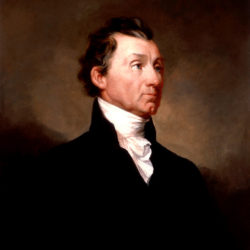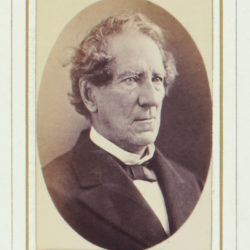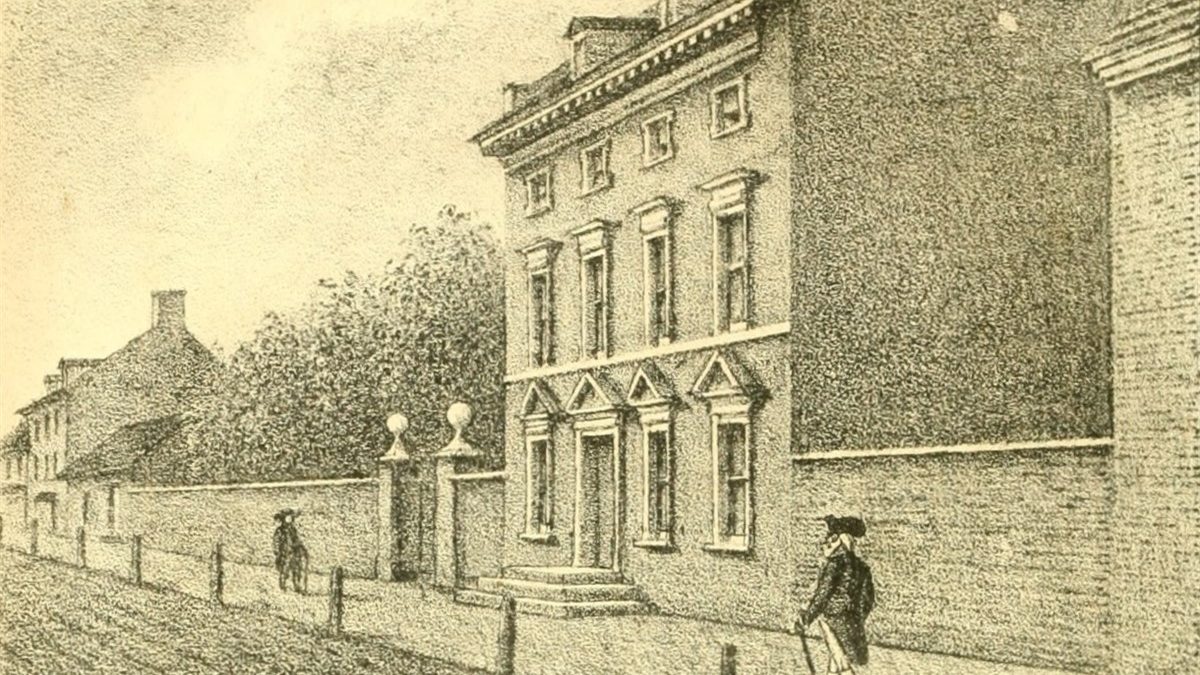Sometimes taking a long view of history provides an insightful perspective on the lives of others. A few years ago, I compiled a timeline of U.S. Presidents who were in office during the antebellum era of the Sams of South Carolina. I focused on William Sams and two particular sons, Lewis Reeve Sams and Dr. Berners Barnwell Sams, M.D. The timeline starts in 1783, when William Sams, at 42, left Wadmalaw Island and moved his family to Beaufort and Datha Island. It ends with the Great Gun Shoot / Big Skedaddle of 1861. The graphic integrates the lives of William, Elizabeth, Lewis Reeve Sams, and his brother Dr. Berners Barnwell Sams, M.D. — with — the terms of our first 16 presidents. This two-page timeline is at the end of this article. The SOURCES section includes links to some excellent biographies of each president, courtesy of the White House Historical Society.
Sams Generational Gap
William and Elizabeth were married in February of 1761 on Wadmalaw Island. He was 19; she was 15. They had seven sons and no daughters. All were born before our first President was inaugurated, except for the youngest, Edward Hext Sams. The events that transpired over the two decades before Edward came into this world in 1790 were significant and probably influenced a generational gap between the sons. Their first four children were Robert, William, John, and Francis, born between 1764 and 1771. Though too young to serve, all were old enough to remember Wadmalaw Island and the American Revolution. Not so for their last three sons. Lewis, Berners, and Edward. They were born in Beaufort (or on Datha) between 1784 and 1790, after the war. This thirteen-year gap between siblings is quite large. However, the fact that it encompasses the entirety of the American Revolution is enormous. The four older sons lived through a war. The younger three sons were largely untouched by conflict, save for the sad state of Beaufort in 1783 [Rowland, page 254.] I have to wonder if this is why three of the four older sons never married.
U.S. Presidents
Six years after William & Elizabeth Sams bought Datha, George Washington was inaugurated on 30 April 1789. It was 73 years later, in 1861, that President Lincoln took office. You might also remember a date from my article and presentation on Sea Island Cotton. William Elliott was the first to plant this unique cotton in Beaufort District, on Hilton Head Island, in 1790. This period of our first 16 Presidents is affectively the Sea Island Cotton era in our corner of the Lowcountry. We don’t know precisely when Sea Island Cotton was first grown on Datha, but it probably occurred sometime during George Washington’s time as President.
It reinforces for me how long ago William Sams lived when I realized the events he witnessed. He was there for our nation’s birth, our first President’s election, and both of Washington’s terms. President Washington left office in March 1797, and William Sams died in January 1798, 11 months into John Adams’s administration.
In the years from 1789 to 1861, we had 16 Presidents. Over the same period, William and Elizabeth Sams had their last son, 34 grandchildren, and numerous great-grandchildren, all born in South Carolina.
As I often do, I relied on Larry Rowland’s comprehensive History of Beaufort County, South Carolina, Volume 1, 1514 – 1861, for insights into the birth of our nation from a Beaufort perspective. I was particularly interested in any connections between the Sams and our Presidents. I did find a few cases where a President visited or traveled through Beaufort District (it wasn’t a county till 1868.) The wealthy Sams certainly knew of these visits at the time, but I could find no evidence of a Sams meeting a President.
Several South Carolina individuals played prominently at the Federal Government level in our early years. One of these is Charles Cotesworth Pinckney (1746 – 1825). He had a great life of accomplishments, from signing the Declaration of Independence to military service, U.S. Ambassador to France, and running twice for President of the United States. While William Sams and Charles Pinckney were born in the same area of South Carolina, William on Wadmalaw and Charles in Charleston, Charles spent most of his youth in Europe from 1753 – 1773. I found no evidence that William and Charles knew each other. Back to our presidents.
George Washington
George Washington visited our area in 1791 [Rowland, pg 259.] He came to see Judge Thomas Heyward, Jr. at his plantation near Coosawhatchie, then the seat of Beaufort District. The President and the Judge knew each other reasonably well, as Hayward was one of four South Carolinians who signed our Declaration of Independence. As you can see from the timeline at the bottom of this article, William Sams was living in the Beaufort area when this visit occurred, but I found no evidence the two ever met. Heyward is buried at Old House Plantation in Ridgeland, SC.
Parson Weems
I also discovered an exciting personal connection while reading Professor Rowland’s first volume. We lived near Dumfries, Virginia, a short drive from Mt. Vernon, George Washington’s historic home and plantation. Mason Locke “Parson Weems” wrote the first famous biography of George Washington. He’s credited with creating the legend of the cherry tree. “I cannot tell a lie. I did it with my little hatchet”. When first married, Parson Weems lived in a small house in Dumfries, VA. Today it is a modest museum, which I visited several times in my 30 years living in the same town! The connection to SC is on page 262 of Rowland’s first volume; Mason Weems died in Beaufort in 1825. He died about 6 miles from where we now live on Dataw Island and is buried about 3 miles from where we once lived in Virginia. Unlike Jethro Gibbs (of NCIS fame), I believe in coincidences. This is undoubtedly one.
Jefferson · Madison · Monroe
Thomas Jefferson, James Madison, and James Monroe were the three Presidents that Lewis Reeve and Berners Barnwell, ‘our’ Datha plantation owners, grew up with. They served in consecutive order from 1801 to 1825. During their tenure, LR and BB graduated from college, came of age, married, started families, and became wealthy plantation owners. These three Presidents were also planters and owned enslaved people.
James Monroe is the only other sitting President of these first 16 that visited Beaufort District while in office. In May of 1819, President Monroe stopped in Beaufort for several days as part of a southern U.S. tour. The tour was instigated by the newly acquired territories of East and West Florida, which Spain had recently ceded.
By the President of the United States—The Town of Beaufort—May its commercial prosperity be fully equal to the advantages afforded by its bar and harbor.
President James Monroe, May 6, 1819, while visiting Beaufort, SC
The Papers of James Monroe at The University of Mary and Washington

By May 1819, Lewis Reeve Sams and his wife Sarah Fripp had four children, with a fifth due at any moment. Berners Barnwell Sams and his wife Elizabeth Fripp were in a similar situation. They certainly would have known of our fifth president’s visit to Beaufort. However, we have no record of either son being interested in politics.
As you can see from the graphic at the end, these three Presidents take the Sams brothers from the Federalist Era, through the Jeffersonian Era, and to the Era of Good Feelings. This 27-year period saw a significant evolution of our federal government.
Our Federal Evolution
The Federalist Era “saw the creation of a new, stronger federal government under the United States Constitution, a deepening of support for nationalism, and diminished fears of tyranny by a central government.” [Wikipedia ] In other words, the States ran their show and learned not to fear the new central government.
In the Jeffersonian Era, the pendulum began to swing the other way. “The national government is a dangerous necessity to be instituted for the common benefit, protection, and security of the people, nation or community—it should be watched closely and circumscribed in its powers.” [Wikipedia ] However, the War of 1812 taught us that trying to defeat a nation (e.g., Britain) with a fractured, state-level militia was a formula for disaster. A standing army was necessary.
The Era of Good Feelings began in 1817 with the inauguration of James Monroe. “The Era of Good Feelings marked a period in the United States’ political history that reflected a sense of national purpose and a desire for unity among Americans in the aftermath of the War of 1812. President James Monroe strove to downplay partisan affiliation in making his nominations, with the ultimate goal of national unity and eliminating political parties from national politics.” [Wikipedia] Many historians are skeptical about how good the feelings were in this era. In Monroe’s second term, sea island cotton entered a depression, but the steamboat era gave Beaufort new life [Rowland, pages 290 – 293.]
The Jacksonian Era lasted about 25 years, from 1825 to 1850. “Broadly speaking, the era was characterized by a democratic spirit. It built upon Jackson’s equal political policy after ending what he termed a “monopoly” of government by elites. Even before the Jacksonian era began, suffrage had been extended to most white male adult citizens, a result that the Jacksonians celebrated. Jacksonian democracy also promoted the strength of the presidency and the executive branch at the expense of the United States Congress while also seeking to broaden the public’s government participation. The Jacksonians demanded elected (not appointed) judges and rewrote many state constitutions to reflect the new values. In national terms, they favored geographical expansionism, justifying it in terms of manifest destiny.” [Wikipedia]
As the Jacksonian Era’s long stretch began, both brothers were entering their fourth decade of life and had lost their first wives. Sarah Sams died in 1825; Elizabeth Sams in 1831. Lewis Reeve did not marry his second wife until ten years later. Berners Barnwell lost his wife in childbirth and remarried quickly.
Civil War Era
The Civil War Era began long before 1860. It started in 1844 in our corner of South Carolina. The Bluffton movement and the road to secession began on July 31, 1844 at a dinner in Bluffton. There, Congressman Robert Barnwell Rhett exhorted the planters in attendance to stand by their principles and protect their mutual interests [Rowland, Volume 1, Chapter 22.] However, 1844 was a Presidential election year, and the politics around this election were intense and convoluted. I must leave the details for another day, but the seeds of thought for some Southerners to move to Texas may have been sewn at this time. Think of Dr. Lewis Reeves Sams, Jr. and Galveston about twenty years later.
Thoughts of War
Re-reading Professor Rowland’s chapter on the Bluffton Movement changed my mind about one notion I’ve been carrying around for a while. Since both BB and his brother Lewis died several years before the outbreak of Civil War hostilities, I assumed they died without the burden of war on their minds. I no longer believe that.
South Carolina was the first state to secede from the United States – just weeks after Lincoln’s election in 1860. Given that talks of succession were centered in Beaufort District for a decade before they died, I must sadly conclude that the possibility of succession burdened the Sams. Whether they believed succession could lead to armed conflict, I don’t know. I hope not; they left large families behind in Beaufort to endure what was to come.
Reverend Richard Fuller (1804 – 1876)
I found a possible strong influencer arising near the Sams family in this era, Reverend Richard Fuller (1804 – 1876.) He was born in Beaufort and is a relative of Lewis Reeve Sams. Richard is Lewis’s brother-in-law via Lewis’s second wife, Frances Fuller. In 1831 Richard converted to the Baptist faith, eventually becoming an intellectual leader of the Baptist movement in the old South. There is no doubt that Lewis Reeve Sams, though 20 years older and already a Baptist, knew and was inspired by him. Both were heavily involved in the Baptist Church of Beaufort congregation. Reverend Fuller’s view of slavery was hotly contested in this political era. “The question of slavery, therefore, was a political and legal question, not a moral or religious one.” [Rowland, page 412] I suspect Lewis Reeve Sams, and maybe even his (non-Baptist) brother Dr. Berners Barnwell Sams, shared this view of slavery.

None of the First 16 Presidents were Born this far South – but Many had Plantations
Another observation I’ll make about these eras of political evolution is geography. Many factors went into the opinions and factions that made up our evolving democracy, but it must have been hard for the Sams to feel connected to any of our forefathers. The plantation is not unique to South Carolina and many, perhaps even most of our first 16 presidents, had plantations. However, none of them were born in South Carolina. Andrew Jackson came closest. He was born in the Waxhaw Region of colonial Carolinas, on the border of North and South Carolina up near Charlotte, NC. He fought for the rights of the “common man” and against “a corrupt aristocracy”; he would not have been a friend to wealthy Beaufortonians like the Sams. His political experience was tied to Tennessee, as was the other Carolina-born President, James K. Polk. Polk was a protege of Jackson’s.
All the others in this sea island cotton period of Presidents were from Virginia (seven) and further north (e.g., PA, NY, MA, NH). The sixteenth was born in Kentucky, Abraham Lincoln.
Both Sams brothers died during the administration of President Franklin Pierce. There would be one more President, James Buchanan, before the 1860 election triggered the armed conflict. That election brought us, President Abraham Lincoln.
Timeline of the Sams and U.S. Presidents
I’ve put together a graphic that integrates the lives of selected Sams with the years each of our first 16 presidents were in office. Included in the SOURCES section below are links to some excellent, short biographies of each president, courtesy of the White House Historical Society.
Presidents-Dataw-Owners-pre-CWBlue is Sams
The top blue timelines are for the Sams. At the top & bottom of the graphic is the time scale starting in 1783 and running to 1861. Inside the blue timelines for each Sams are their ages in the associated year. For instance, when William and Elizabeth bought Datha Island, he was 42, and she was 37. William died at age 56, and Elizabeth at age 67. For Lewis Reeve and Berners Barnwell, I’ve identified when they reached an age of majority (per English Common Law practice, i.e., age 21), their ages when they married (both times), and when they died.
For a complete picture, there is a document at the end of this article that covers the timeline of their lives, including their age at life events like the birth and death of parents, spouses, and children.
Green is Presidents
The green blocks in the graphic below the Sams family members identify the President’s years in office. The dates after their names are birth-death. The green blocks to each name’s immediate right show when they were inaugurated and how long they served in office. To add some context, the generally accepted periods of our federal history are identified (e.g., Federalist Era, Jeffersonian Era, etc.) The SOURCE section at the end links to some excellent Wikipedia articles on each of these eras and how they differed, or more accurately, how our federal government’s relationship with its citizens evolved.
Sources
Holden, Joel and Riski, Bill – Family Tree for Sams of Dataw Island, accessed October 12, 2020.
Rowland, Lawrence S. et al. – The History of Beaufort County, South Carolina, Volume 1, 1514 – 1861
White House Historical Society:
Wikipedia:
Federalist Era
https://en.wikipedia.org/wiki/Federalist_Era
Jeffersonian Era
https://en.wikipedia.org/wiki/Jeffersonian_democracy
Era of Good Feelings
https://en.wikipedia.org/wiki/Era_of_Good_Feelings
Jacksonian Era
https://en.wikipedia.org/wiki/Jacksonian_democracy
Civil War Era
https://en.wikipedia.org/wiki/American_Civil_War
Coosawhatchie, SC
https://en.wikipedia.org/wiki/Coosawhatchie,_South_Carolina
#52Sams


